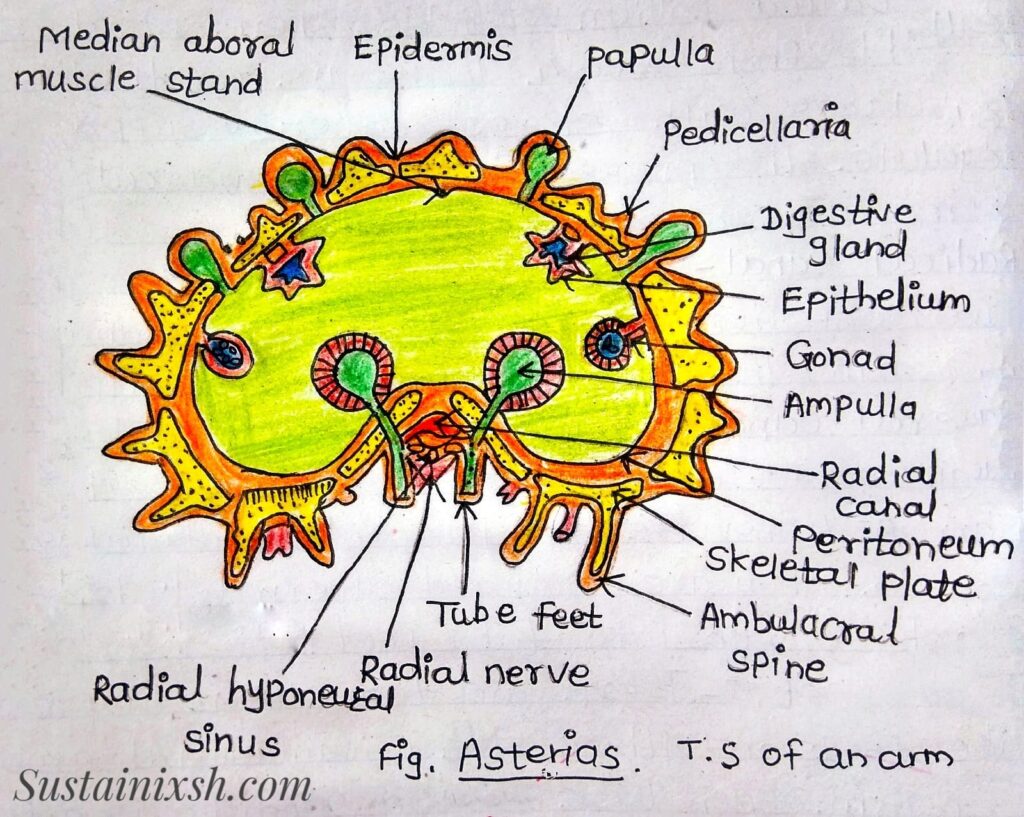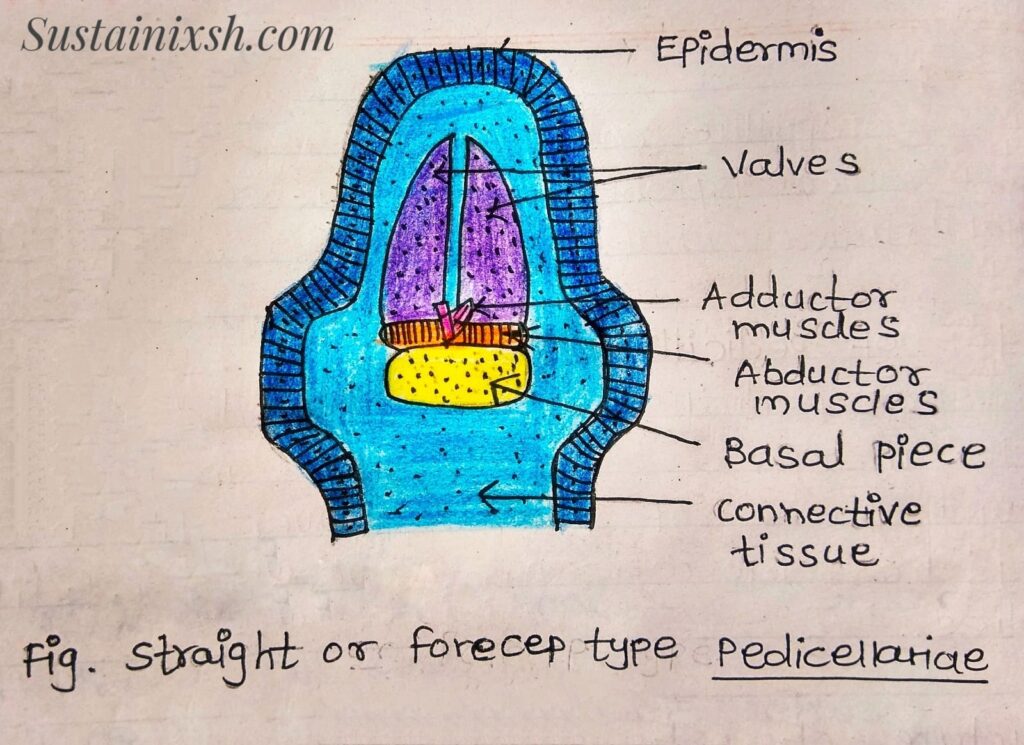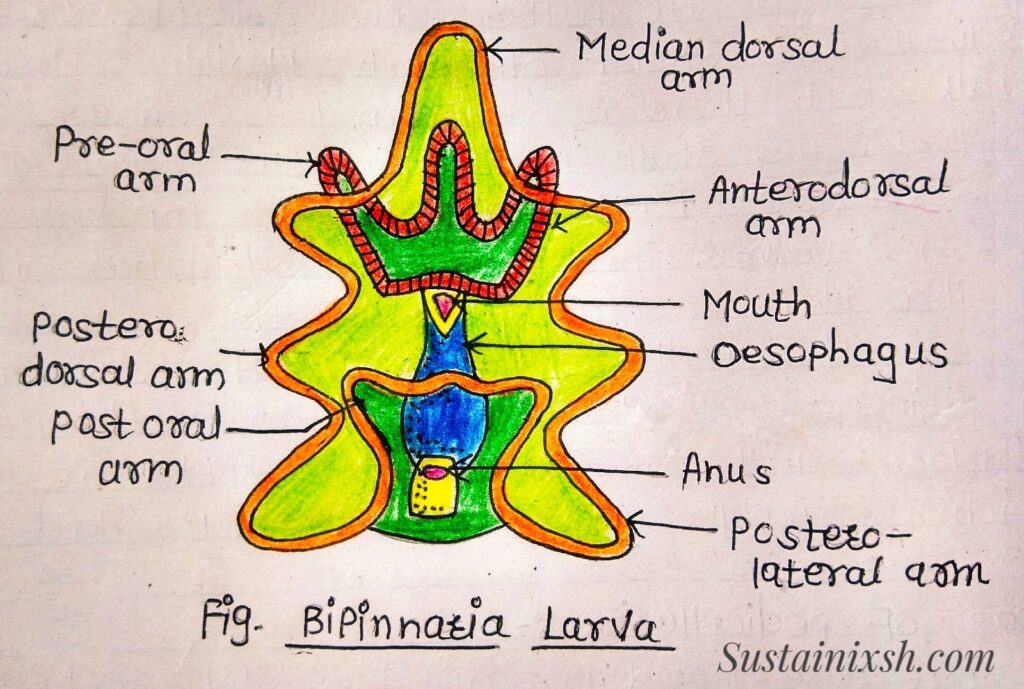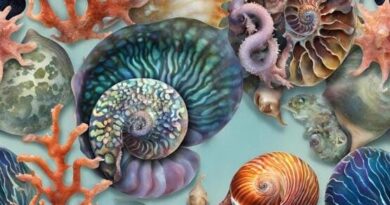Study of Water Vascular System of Starfish
Title:- Study of Water Vascular System of Starfish
Water Vascular System:-
The water vascular system or ambulacral is a sort of hydraulic pressure mechanism and consists of a madreporite, stone canal, ring canal, radial canal, Tiedmann’s bodies, pollian vesicle, Lateral canal & tube feet. This system is concerned with locomotion.
1) Madreporite – A flat disc with radiating grooves at the bases of bivium It is a hard, rounded, Calcarious plate on the aboral surface. It leads to a stone canal.
2) Stone Canal – A ampulla, opens into a vertical ‘S’ shaped stone canal. It is a cylindrical tube. Supported by calcareous rings. The stone canal runs downward from the madreporite to join the ring canal.
3) Ring Canal– It is a wide, five-sided, or pentagonal, ring like canal situated around the mouth. It lies just the inner side of the peristomal ring.
4) Tiedmann’s Bodies – The ring canal gives off inter-radially a pair of small vesicles on its inner side called racemose gland or Tiedmann’s Bodies. These are small, yellowish rounded bodies. There are only nine Tiedmann’s bodies, the 10th being absent & its position taken by the stone canal. Tiedmann’s bodies manufacture the amoebocytes which are phagocytic in function.
5) Pollian vesicles – The ring canal gives off in each inter-radius a large, thin-walled pear-shaped Sac called Pollian vesicles. Their number is variable from 2 to 4. These are contractile structures with store water & supposed to regulate the pressure in the water vascular system & manufacture amoeboid cells.
6) Radical Canal – Ring Canal from its outer surface gives off five, long, ciliated radical canals into each arm. These canals run up to the tip of the arm.
7) Lateral Canal – During the course of radial canals it gives off on either side a series of short, narrow, transverse branches, called lateral or Podial Canals. They are arranged alternately long and Short & open into tube feet.
8) Tube Feet – There are two alternating rows of tube feet on either side in the ambulacral groove of each arm. Each tube feet or podium is a hollow, elastic, thin-walled sac-like part is called Ampulla, a middle Podium & lower disc, like structure- Sucker.
The ambulacral system (water vascular system) mainly helps in locomotion, and adherence to substratum & plays an important role in Respiration.

- Temporary Preparation of Gonads from Starfish:-
Asterias is unisexual animal. The male gonads (testis) & female gonads (ovaries) have similar forms & structures but they differ in color. The testis are pale gray while the ovaries are pink to orange in the fresh state.
•Location – There are a pair of Gonads. Each pair is lie-free laterally in the base of each arm between the pyloric caeca & Ampullae.
•Structure – Each gonad is a branched structure Consisting of masses of small rounded follicles like bunches of grapes.

•Study of T.S of an arm & Types of Pedicellariae:-
•T.S. Passing through the arm of Starfish:-
- The arm is covered by cuticle, ciliated epidermis & thick dermis.
- The dermis contains numerous perihaemal spaces and ossicles.
- The epidermis and dermis show spines, Pedicellariae, and dermal branchiae.
- In the T.S. the aboral surface appears thick and convex arch while the oral surface is like an inverted ‘U’ shape.
- The arm encloses Coelom which contains a fair of pyloric Caeca, each suspended by two longitudinal mesenteries from the aboral surface.
- On the oral surface, the ambulacral groove is Supported by two elongated ambulacral ossicles meeting at the summit of the groove.
- Above the ambulacral groove runs a radial canal which is jointed on each side by a podial branch to two ampullae called lateral water Canals.
- A radical hyponeural sinus is seen below the radial canal.

•Types of Pedicellariae:- The pedicellariae are modified spines that occur in space between spines in clumps around the bases of spines all over the body. They are microscopic pincer-like or jaw-like bodies.
• Structure of Pedicillariae:-
The stalked or pedunculate type of pedicellariae is found in the genus Asterias. Each Pedicellariae consists of a short, Flexible & fleshy stalk, but there is no internal calcareous Support. The stalk bears three calcareous plates or ossicles, a basilar Plate at its top & two jaws or valves. The jaws are articulated with basilar plates & serrated along their opposed edges. The pedicellariae having three calcareous pieces & stalk are called forcipulate pedicellariae. They are covered with epidermis which is richly supplied with sensory & gland cells.
•Types of pedicellariae:-
There are two types of forcipulate pedunculate Pedicellariae found in Asterias. These are forceps or straight types of scissors or Crossed types.
•Foreceps or Straight Type:-
It is a simple type in which the two jaws are more or less straight & attached basically to the basal piece. When Pedicellariae is closed the jaws remain parallel & meet throughout their length like Foreceps. The jaw can be opened or closed by one pair of abductor muscles to open them.
•Functions of Pedicellariae:-
The pedicellate performs different functions. They are useful for the Protection of delicate skin, gills, or papulae & keep the body surface free from debris & foreign organisms. They also serve as defensive & offensive organs.

•Study of larval forms in Echinodermoda:- (Bipinnaria Lava )
- This is the free-living larval stage of Asteroidea.
- Bilaterally symmetrical & somewhat angular in shape.
- The anterior end of the larva is enlarged to form a Pre-oral lobe. The ciliated border of the pre-oral lobe is Called the Pre-oral bond which encircles the mouth. The pre-oral bond separates completely from the rest of the longitudinal bond or post-oral bond.
- The larva develops three lobes on either side of the body which are bordered by post-ciliary bond.
- The larva is free-swimming.
- The larva shows the mouth, esophagus, stomach, and intestine.
- The bipinnaria larva changes into the next larval stage called branchiolaria larva.






Your words resonate with a truth that feels universal — as though they’ve tapped into something deeply human.
Thank you! Stay tuned for new blogs.